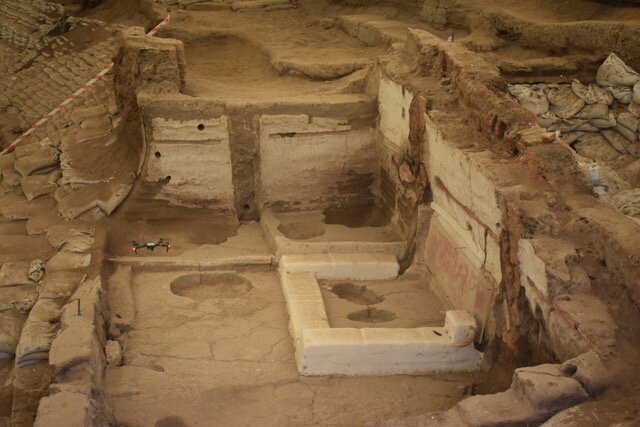As part of the continuing development of the visitor experience at the site of Çatalhöyük in Turkey, a combined team of researchers from EMOTIVE, based at the University of York (UK), ATHENA (Greece), and INRIA (France), have traveled together to Turkey this autumn. The goal has been to capture new digital images of the excavation areas and replica houses at the site for use in an EMOTIVE virtual reality (VR) experience.
It was a different type of trip to Çatalhöyük than in the past for returning members of the team, as the dig house was closed up for the season and the weather was…chilly!

The week spent on-site resulted in the production of over 12,000 images (yes, 12,000 – that isn’t a typo!), taken with DSLR cameras, a helmet mounted with six GoPro cameras, and a drone. These images are being put together to create the background and active environment for a VR experience set jointly in the excavation areas and replica houses. INRIA is providing photographic site capture via camera and drone, and novel Image-Based Rendering (IBR) technology for the project; NOHO is designing the graphics and artistic elements for the experience, ATHENA is designing and developing user interaction for the virtual environment; CNR is providing the 3D moulds; and the University of York is providing the conceptual and interaction design, scriptwriting, and audio and text content.

Situating the VR experience within both the excavated areas and the replica houses allows us to talk about the past in the present. Multiple users will be able to interact together in the VR environment to explore social issues that affect our neighbourhoods (both in the past at Çatalhöyük, and in visitors’ own present-day neighbourhoods). These issues are likely to touch on the spread of wealth, equality, how people deal with aging and treat seniors, how we negotiate death, privacy and personal space. The VR experience asks participants to collaborate in thinking about how such things might have been handled in the past, and then to consider how participants’ own ideas on these issues in the present are shaped and formed by social processes and material culture today.
In a mirror to the overall co-operative nature of the project, then, the VR experience asks participants to act cooperatively as well, undertaking interlocking activities within the same space to reach shared objectives. Critical negotiation of points-of-view, reenactment of cultural norms, and debate about the relationships between people and their environments (both physical and social) feature heavily. Çatalhöyük, with its history of egalitarianism and unique socio-cultural ideals, offers the perfect intellectual space to explore these themes…and, thanks to INRIA’s IBR is pretty stunning to visit in virtual reality too!

For more images of the team’s time at Çatalhöyük, and to continue watching the project as it develops, follow EMOTIVE on our social media accounts at Twitter, Facebook, and Instagram.
Blog post written by L. Meghan Dennis, PhD Researcher, University of York.
